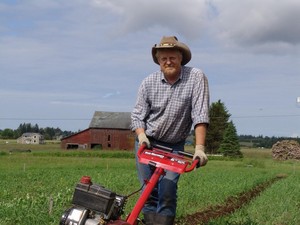24 Aug Mon 2009
Squash - One of the First Domesticates For Good Reasons
This year I am doing a squash experiment at another farm a couple of miles away. Because squashes have imperfect flowers (i.e. each blossom only displays the organs of one sex - male or female), they rely on insect pollination to produce fruit. This means isolation from other varieties of the same species if you want to save seed. For example, you can grow Butternut squash (Cucurbita moschata) right next to Buttercup (Cucurbita maxima) if you like, but not Buttercup next to Hubbard (another Cucurbita maxima). The isolation distance is usually given as a quarter-mile, but since we have only 5 acres, there is no quarter-mile distance, even on the diagonal from the northeast corner to the southwest corner. I usually plant only one variety of each species, but I still come up with interesting results.
In 2006, I had a Blue Hubbard planted right next to my Butternut and I got a smaller Hubbard that was the same shade of brown as the Butternut. This doesn't make sense as a cross, UNLESS the two species actually crossed - similar to a donkey and a horse crossing to produce a mule. Perhaps it was not a hybrid, but just a color mutation in the Blue Hubbard gene pool. I kept the seeds and finally got a chance to grow them out in an isolated environment this year, at another farm. So far, they look like pale blue Hubbards, but they are still immature, so the final color is still anybody's guess, as is the texture and taste of the squash meat inside.
Since they are at another farm, I don't see them every day and I have been a bit lax on getting over there each week - it has been more like once a month. However, they are doing fine and we went over to weed and water them yesterday (Sunday). Their intrinsic squash hardiness got me thinking along the same lines I used to pursue in grad school. Why domesticate squash early? [Per Heather Pringle (Science 1998, 282:1446), the coastal Ecuadorians were growing Cucurbita moschata 10,000 years ago, and the early Mexicans cultivated Cucurbita pepo (the species of pie pumpkins and summer squashes) as early as 9975 years ago.] The answers were bloody obvious. Squash can do a lot with little moisure and they outcompete weeds via their vining characteristics. We have a lot of smartweed around here and my squashes were holding their own, something my wheat cannot do. While I was weeding, I had a sudden appreciation for the smarts of the native peoples who planted squash early on. In the transition from hunting/gathering to agriculture, the seasonal round (following the seasons around the landscapes for different foods - different times and places for the Camas roots and salmon, for example) could still be maintained IF the domesticates were hardy and relatively pest-free. Squash fits the bill in all respects. It would be quite easy to plant early and wait until the plants were well-established, then just do maintenance weeding once a month, as the group passed through the area on the seasonal round. The squashes could be planted specifically in the areas where fall hunting or foraging camps would be used, so that the mature fruits could be protected from any rodents. Perhaps this was not really a problem. I only lose one or two fruits in the fall myself, and we don't have a dog or any other animal that patrols the garden other than natural predators.
There are many theories of how agriculture got started, but the interaction of random mutation and human agency is most likely. A hardy Cucurbit that has a lot of calories (153 calories per pound for squash is a good average among varieties) and stores well would be most welcome during the winter. The ease of growing these squashes would certainly endear the plants to native people and the archaeological evidence indicates they were among the first domesticates. I like squash and I grow plenty. It is easy, yields well, stores well, is quite nutritious and tastes delicious. It also has a long history.

